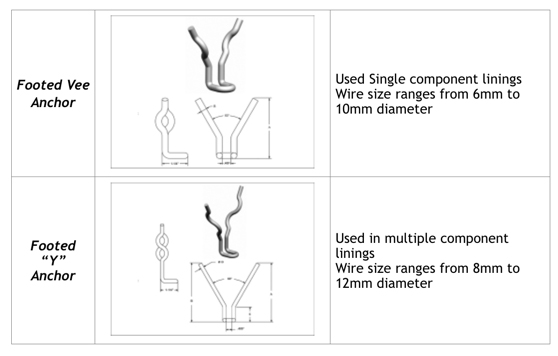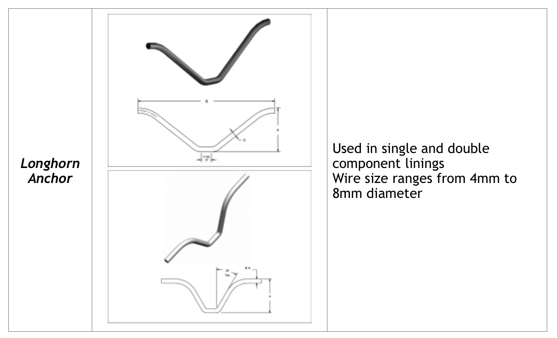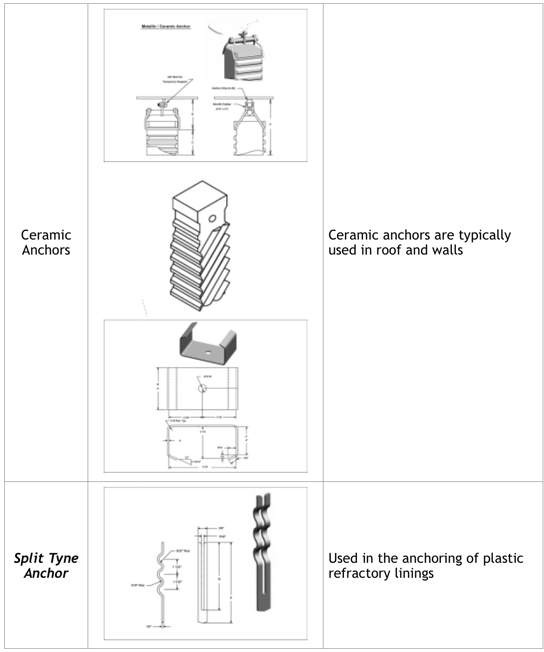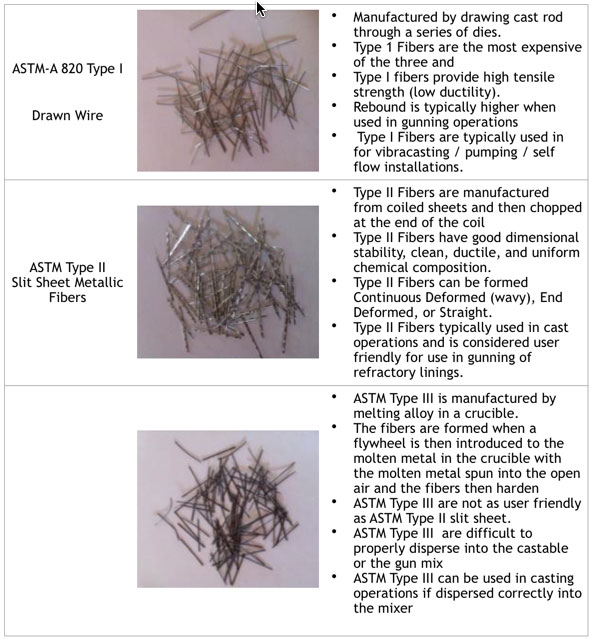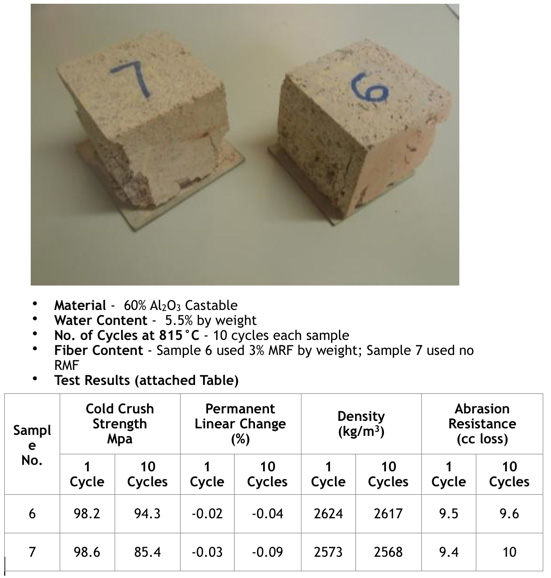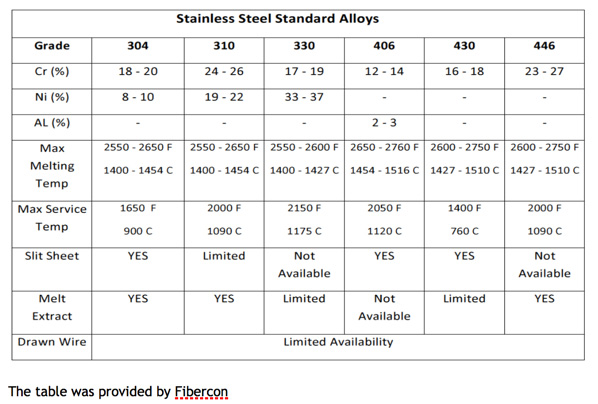-
1.Shelf LifeDescription of this FAQ section goes here...
 Mike Linck
Mike Linck 19-06-2015
19-06-2015ACI 547 defines the shelf life of a castable refractory as “Maximum time interval during which a material may be stored and remain in a usable condition”. The shelf life is typically listed on the manufacturers technical data sheet for the material and is used a guideline for the maximum time period that the material may be incorporated into the installation. Castable materials used after the predetermined shelf life should not be used in a refractory installation.
Was this helpful? 6
6 0
0
Hits: 967 Mike Linck
Mike Linck 19-06-2015
19-06-2015The shelf life of a refractory material is typically determined by the manufacturer of the refractory material. The shelf life is typically listed on the manufacturer’s technical data sheet with either the manufacture date or the use by date marked on the refractory bag (container).
The shelf life of a refractory material is determined by the exposure of the binders used in the refractory material to the environment, e.g. moisture, over the passage of time. The shelf life of a refractory material can range from 3 to 18 months depending on the manufacturer and the specific material. A typical shelf life for a monolithic material is 12 months however this can be affected by the method of storage and climatic conditions during shipment and storage.
Was this helpful? 4
4 0
0
Hits: 739 Mike Linck
Mike Linck 19-06-2015
19-06-2015Plastic refractories have a specified shelf life that is determined by the manufacturer. The shelf life of a refractory plastic can range from 15 days to 12 months depending on the manufacturer and the specific material. The typical shelf life of a refractory plastic is 6 months however this can be affected by the method of storage and climatic conditions during shipment and storage.
Was this helpful? 3
3 0
0
Hits: 443 Mike Linck
Mike Linck 19-06-2015
19-06-2015Refractory bricks that have been fired during manufacture do not have a specified shelf life however certain bricks may be damaged due to exposure to the environment. Insulation Fire Bricks and dolomite bricks should be stored in a manner that protects bricks from moisture.
Was this helpful? 2
2 0
0
Hits: 592 Mike Linck
Mike Linck 19-06-2015
19-06-2015There are many different anchors shapes used in the design of refractory lining. The anchor type of anchor chosen for the refractory linings is typically determined by the lining designer and is based on the type material being installed. Refractory anchors can range from simple metallic “vee” to ceramic anchors. As shown below anchors come in many different shapes and styles as shown with a few examples below:
Was this helpful? 0
0 0
0
Hits: 453 Mike Linck
Mike Linck 19-06-2015Was this helpful?
19-06-2015Was this helpful? 0
0 6
6
Hits: 349 Mike Linck
Mike Linck 19-06-2015
19-06-2015PMI (Positive Material Identification) should be incorporated to determine the metallic grade of the refractory anchor. This requirement may be waived, if the API method of color coding has been implemented or the material grade has been etched on to the surface of the anchor. Knowledge and verification of the anchor material will assist in the qualification of the weld procedure and personnel qualification.
Was this helpful? 1
1 0
0
Hits: 281 dmallett
dmallett 19-06-2015
19-06-2015The material used to fabricate the refractory anchor should be selected based on the operation conditions and service of the lining. Typically, the choice of the anchor material is based on the long term exposure to the operating temperature however other factors such as intermittent operation and corrosion.
Was this helpful? 0
0 0
0
Hits: 287 dmallett
dmallett 19-06-2015
19-06-2015The stud welding of anchors has gained acceptance over the past decade. There are numerous applications that utilize stud welding however this installation method should follow the same quality control guidelines (PRQ and WPS) as required for welded metallic anchors.
Was this helpful? 0
0 0
0
Hits: 241 dmallett
dmallett 19-06-2015
19-06-2015Most specifications do not require a PRQ or WPS for the welding of refractory anchors however the implementation of these qualifications are considered a good practice and should be incorporated into all projects where the welding of refractory anchors is an integral part of the refractory design.
Was this helpful? 0
0 0
0
Hits: 206 dmallett
dmallett 19-06-2015
19-06-2015The band stress of an anchor is based on the diameter or thickness of the anchor material and the radius of the bend, e.g. an 8 mm diameter anchor has a radius of minimum of 25 mm. A tighter bend radius can leave the anchor with more localized stress which can resulting of the anchor material.
Was this helpful? 0
0 0
0
Hits: 178 dmallett
dmallett 19-06-2015Was this helpful?
19-06-2015Was this helpful? 0
0 0
0
Hits: 176 dmallett
dmallett 19-06-2015Was this helpful?
19-06-2015Was this helpful? 0
0 0
0
Hits: 159 Mike Linck
Mike Linck 24-08-2015
24-08-2015The typical refractory anchor has the tip of the longest leg of the anchor that is not greater than 1” (25mm) from the surface of the refractory lining. Some specifications require that other leg of this anchor be ½” (13mm) shorter than the long leg of the anchor which would place the tip of this anchor 1 ½” (38mm) from the surface of the refractory lining. These offset legs are used to prevent a separation plane at the tip of the refractory anchors from occurring during the dry out or operation of the unit.
Typical anchor spacing in a refractory lining will vary depending on the thickness and density of the refractory lining. Other than PIP, there are no stated industry standards spacing of anchors, there are established industry guidelines that can be followed to ensure that there are a sufficient number of anchors to support the monolithic lining. There are several refractory material manufacturers who have issued guidelines for the use of anchors for their material however these are guidelines and not actual refractory designs.
Was this helpful? 0
0 0
0
Hits: 189 dmallett
dmallett 24-08-2015
24-08-2015The typical mix ratio of reinforcing metallic fibers is 2% up to 3.5% by weight of the refractory material. Addition of RMF.
Was this helpful? 0
0 0
0
Hits: 118 Mike Linck
Mike Linck 24-08-2015
24-08-2015ASTM Standard A820 has established three (3) classifications of stainless steel fiber which are as follows:
Benefits related to the use of metallic fibers include:
- Controlled and uniform cracking of the refractory lining
- Strength retention of the refractory lining,
- Minimize permanent linear change,
- Increased lining toughness
- Improved thermal shock resistance
Increased Lining Toughness
The effectiveness of metal reinforcing fibers related to toughness is based on a comparison of physical properties of the samples fired during one (1) cycle versus the physical properties of specimens taken from the test sample using no MRF and sample using 3% MRF. The strength retention as measured by cold crushing strength was higher for the sample using the MRF as compared the sample not using MRF after ten (10) cycles in the furnace.
 The PLC for the sample using MRF was half as much as the sample not using MRF. While the abrasion resistance of the samples using MRF increased by 1% versus the 4% increase of the sample not using the MRF. The change in density between the two samples was minimal. The photo of the tow (2) samples shows a significant difference between the two samples after the cold crush test. Sample 7 showed fractures on the sides along with a breaking plane through the mid section of the sample whereas Sample 6 remained in one piece with visible cracking on the sides of the specimen with minimal material lossWas this helpful?
The PLC for the sample using MRF was half as much as the sample not using MRF. While the abrasion resistance of the samples using MRF increased by 1% versus the 4% increase of the sample not using the MRF. The change in density between the two samples was minimal. The photo of the tow (2) samples shows a significant difference between the two samples after the cold crush test. Sample 7 showed fractures on the sides along with a breaking plane through the mid section of the sample whereas Sample 6 remained in one piece with visible cracking on the sides of the specimen with minimal material lossWas this helpful? 0
0 0
0
Hits: 123 dmallett
dmallett 19-06-2015Was this helpful?
19-06-2015Was this helpful? 2
2 0
0
Hits: 197 dmallett
dmallett 19-06-2015Was this helpful?
19-06-2015Was this helpful? 0
0 3
3
Hits: 189 dmallett
dmallett 19-06-2015Was this helpful?
19-06-2015Was this helpful? 2
2 0
0
Hits: 156 dmallett
dmallett 19-06-2015Was this helpful?
19-06-2015Was this helpful? 0
0 0
0
Hits: 166 dmallett
dmallett 19-06-2015Was this helpful?
19-06-2015Was this helpful? 0
0 0
0
Hits: 163 dmallett
dmallett 19-06-2015Was this helpful?
19-06-2015Was this helpful? 0
0 0
0
Hits: 108 dmallett
dmallett 19-06-2015Was this helpful?
19-06-2015Was this helpful? 0
0 0
0
Hits: 95 dmallett
dmallett 19-06-2015Was this helpful?
19-06-2015Was this helpful? 0
0 0
0
Hits: 91 dmallett
dmallett 19-06-2015Was this helpful?
19-06-2015Was this helpful? 0
0 0
0
Hits: 94 dmallett
dmallett 19-06-2015Was this helpful?
19-06-2015Was this helpful? 0
0 0
0
Hits: 146 dmallett
dmallett 19-06-2015Was this helpful?
19-06-2015Was this helpful? 1
1 1
1
Hits: 189 dmallett
dmallett 19-06-2015Was this helpful?
19-06-2015Was this helpful? 0
0 0
0
Hits: 124 dmallett
dmallett 19-06-2015Was this helpful?
19-06-2015Was this helpful? 1
1 0
0
Hits: 119 dmallett
dmallett 19-06-2015Was this helpful?
19-06-2015Was this helpful? 1
1 0
0
Hits: 103 dmallett
dmallett 19-06-2015Was this helpful?
19-06-2015Was this helpful? 0
0 2
2
Hits: 97 dmallett
dmallett 19-06-2015Was this helpful?
19-06-2015Was this helpful? 0
0 0
0
Hits: 82 dmallett
dmallett 19-06-2015Was this helpful?
19-06-2015Was this helpful? 0
0 0
0
Hits: 73 dmallett
dmallett 19-06-2015Was this helpful?
19-06-2015Was this helpful? 0
0 0
0
Hits: 65 dmallett
dmallett 19-06-2015Was this helpful?
19-06-2015Was this helpful? 0
0 1
1
Hits: 77 dmallett
dmallett 19-06-2015Was this helpful?
19-06-2015Was this helpful? 0
0 0
0
Hits: 75 dmallett
dmallett 19-06-2015Was this helpful?
19-06-2015Was this helpful? 0
0 0
0
Hits: 108 dmallett
dmallett 19-06-2015Was this helpful?
19-06-2015Was this helpful? 0
0 0
0
Hits: 84 dmallett
dmallett 19-06-2015Was this helpful?
19-06-2015Was this helpful? 0
0 0
0
Hits: 77 dmallett
dmallett 19-06-2015Was this helpful?
19-06-2015Was this helpful? 0
0 0
0
Hits: 80 dmallett
dmallett 19-06-2015Was this helpful?
19-06-2015Was this helpful? 0
0 0
0
Hits: 71 dmallett
dmallett 19-06-2015Was this helpful?
19-06-2015Was this helpful? 0
0 0
0
Hits: 106 dmallett
dmallett 19-06-2015Was this helpful?
19-06-2015Was this helpful? 0
0 0
0
Hits: 92 dmallett
dmallett 19-06-2015Was this helpful?
19-06-2015Was this helpful? 0
0 0
0
Hits: 74 dmallett
dmallett 19-06-2015Was this helpful?
19-06-2015Was this helpful? 0
0 0
0
Hits: 72 dmallett
dmallett 19-06-2015Was this helpful?
19-06-2015Was this helpful? 0
0 0
0
Hits: 58 dmallett
dmallett 19-06-2015Was this helpful?
19-06-2015Was this helpful? 0
0 0
0
Hits: 63 dmallett
dmallett 19-06-2015Was this helpful?
19-06-2015Was this helpful? 0
0 0
0
Hits: 68 dmallett
dmallett 19-06-2015Was this helpful?
19-06-2015Was this helpful? 1
1 0
0
Hits: 133 dmallett
dmallett 19-06-2015Was this helpful?
19-06-2015Was this helpful? 0
0 0
0
Hits: 108 dmallett
dmallett 19-06-2015Was this helpful?
19-06-2015Was this helpful? 1
1 0
0
Hits: 103 dmallett
dmallett 19-06-2015Was this helpful?
19-06-2015Was this helpful? 0
0 0
0
Hits: 93
FAQ
2.Anchors
3.Installation Technique
Description of this FAQ section goes here...
4.Testing
Description of this FAQ section goes here...
5.Packaging
Description of this FAQ section goes here...
6.Project Setup and Engineering Controls
Description of this FAQ section goes here...
7.Quality Control
Description of this FAQ section goes here...



